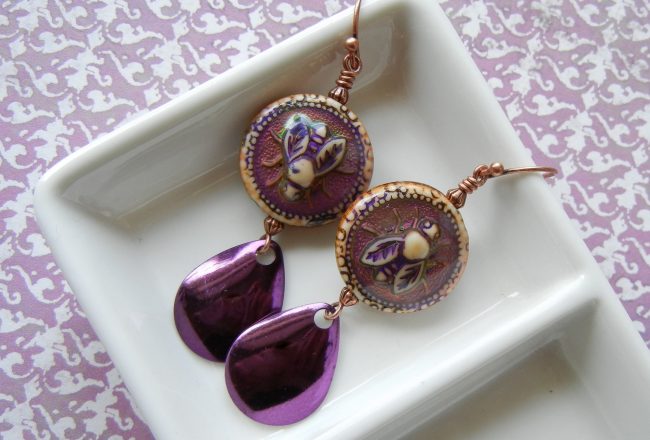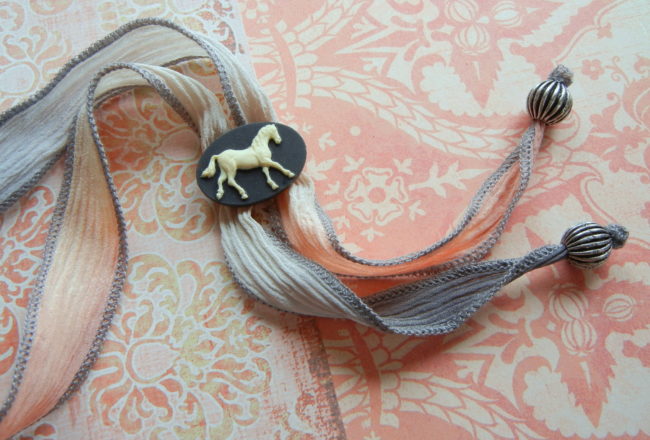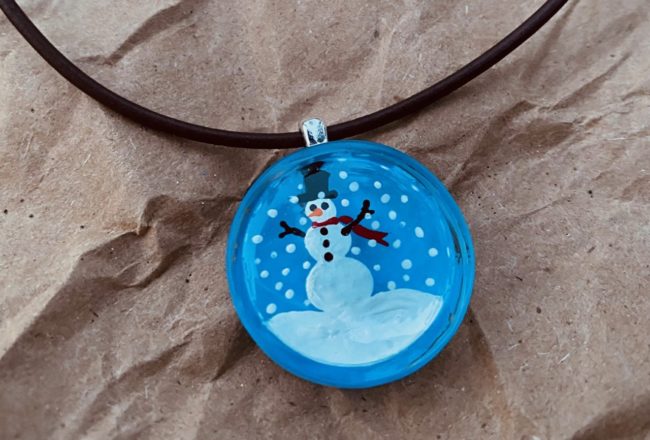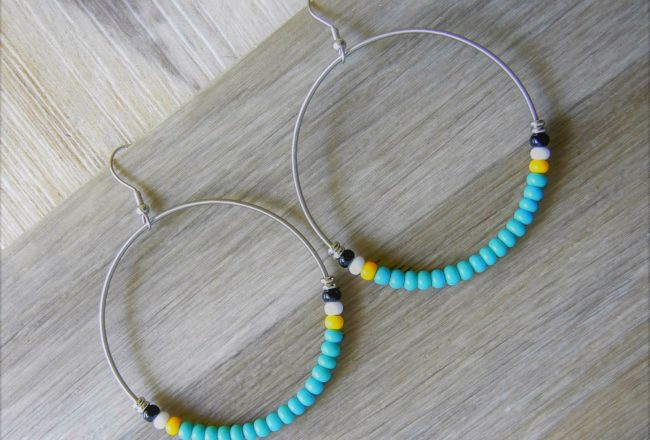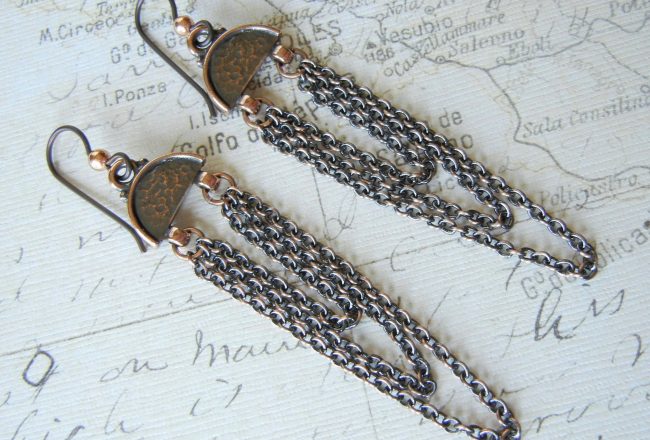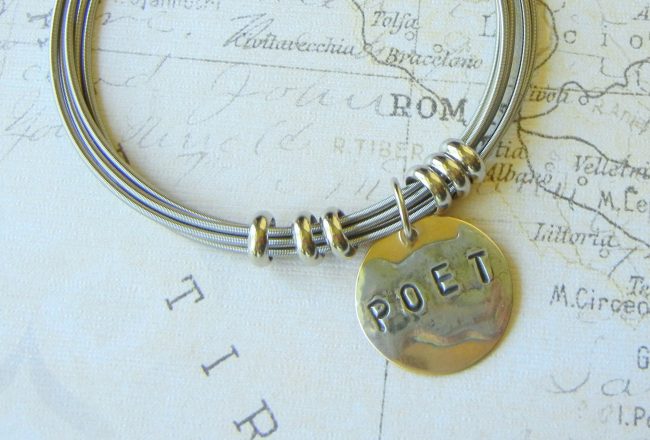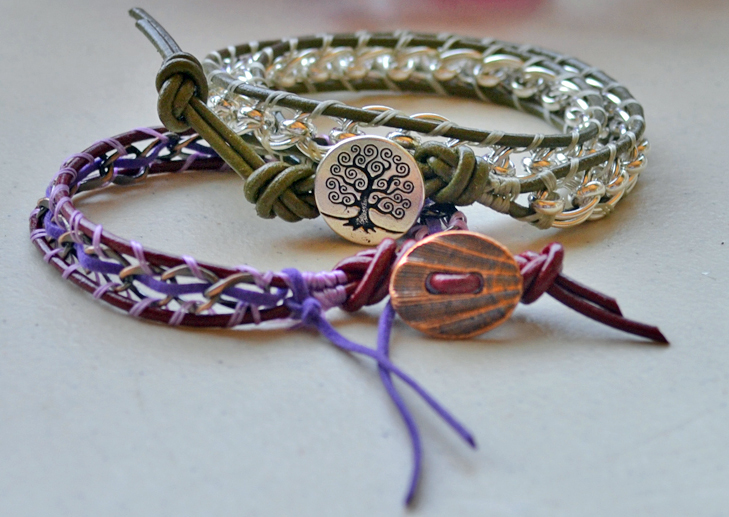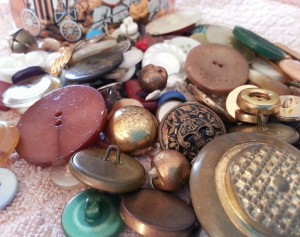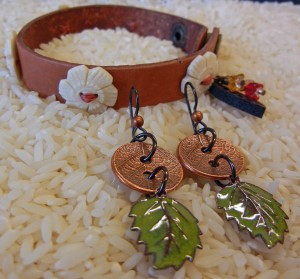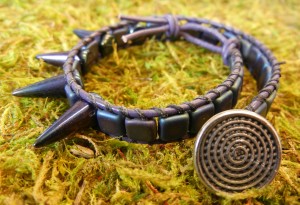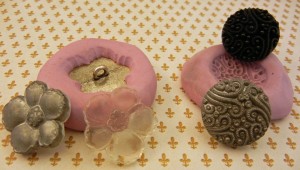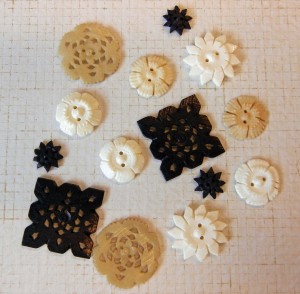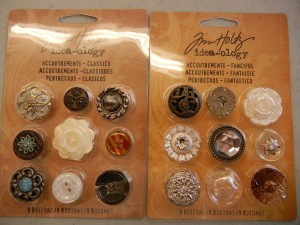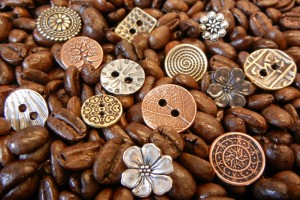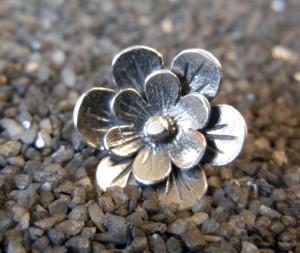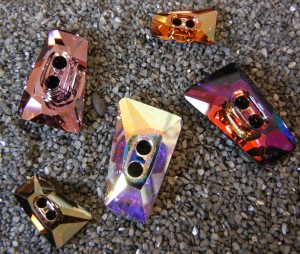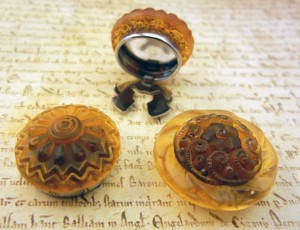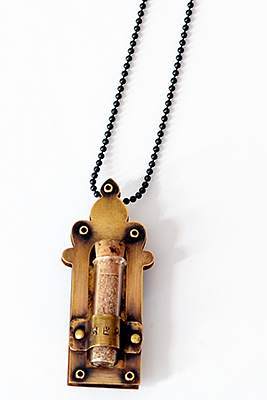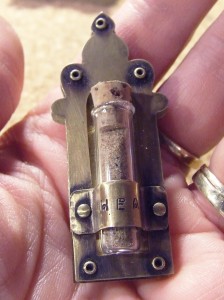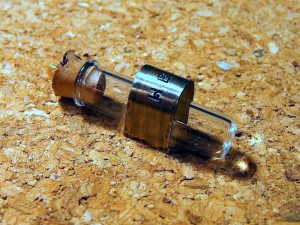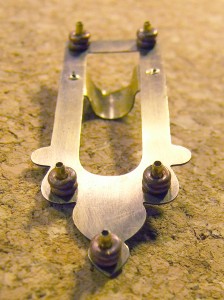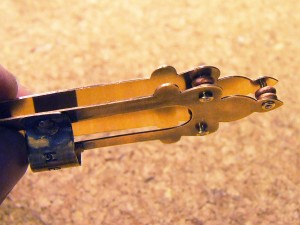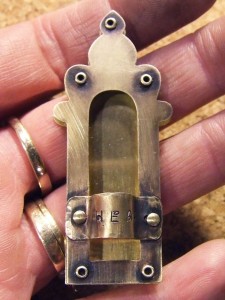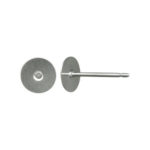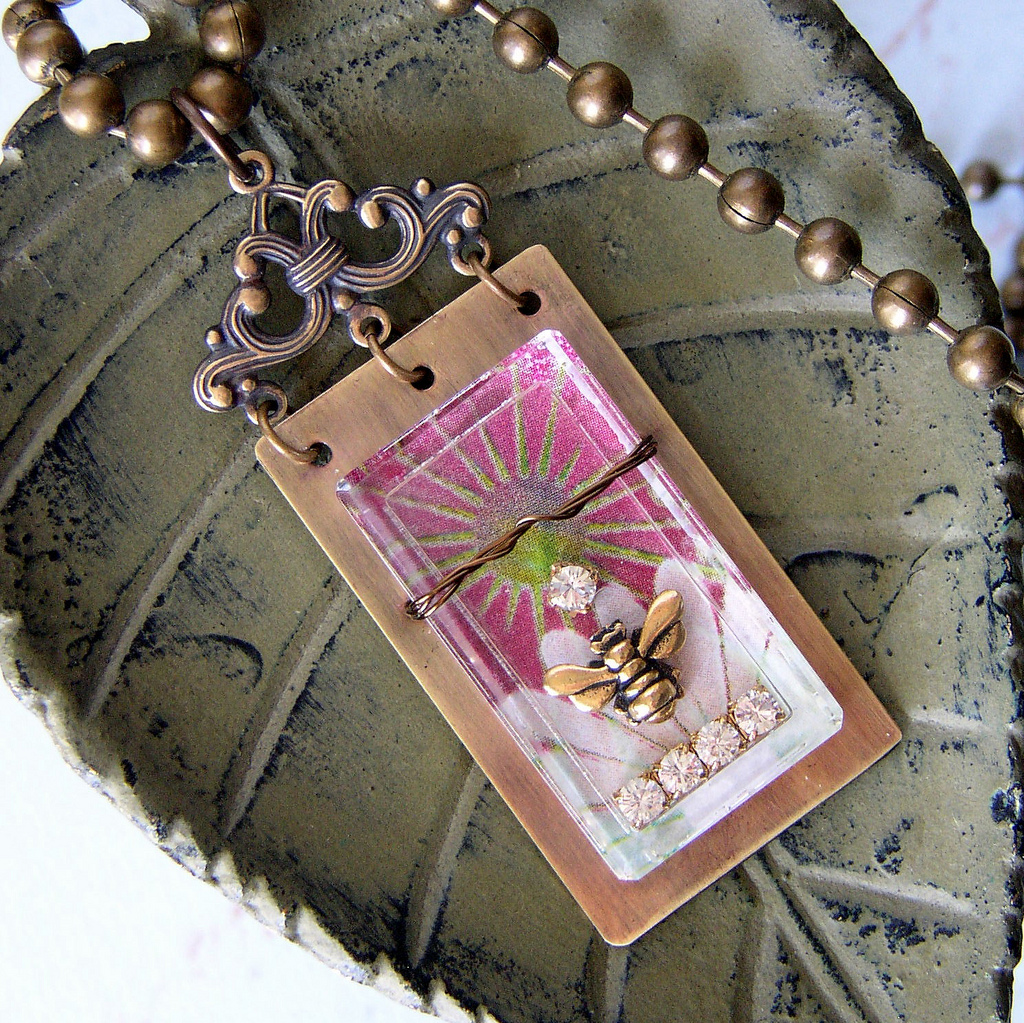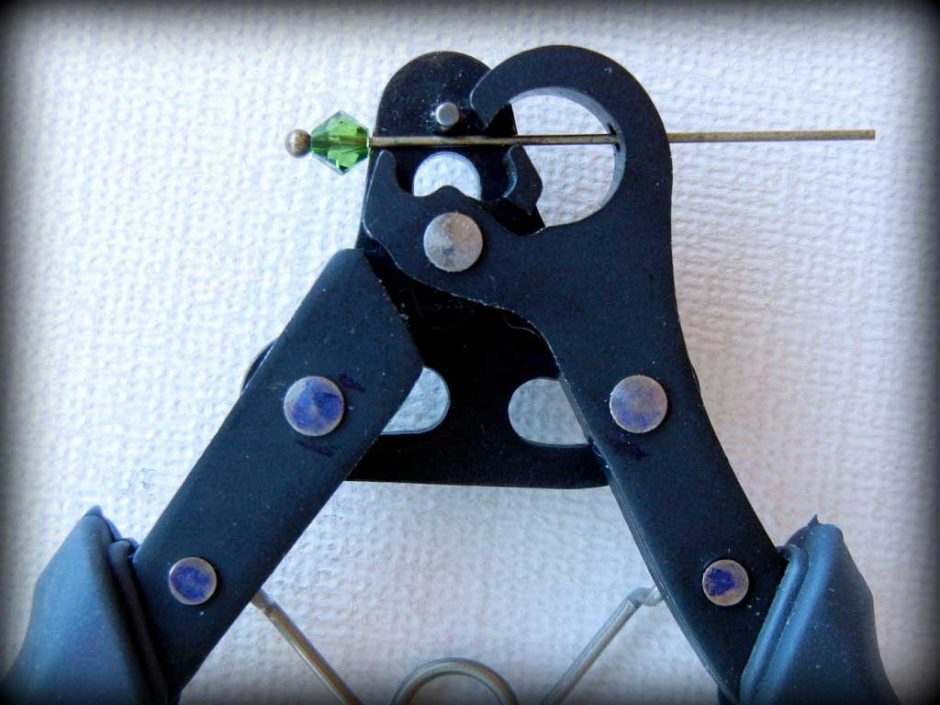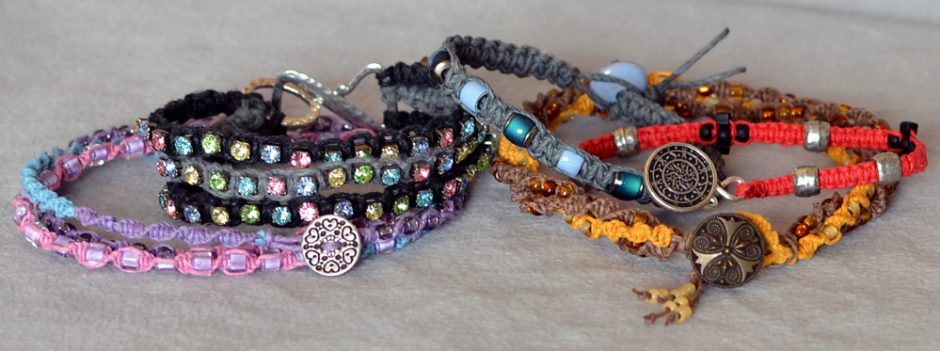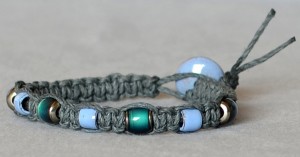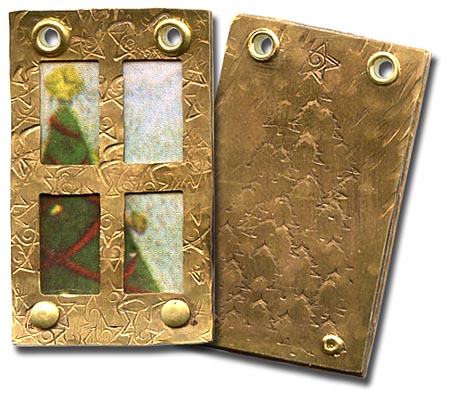Making wrapped bracelets just got easier because this simple lashing technique takes just minutes to learn. You can combine leather cord with rhinestone chain for a sophisticated style or use ball chain and leather for an industrial look.
How to Make a Lashed Chain & Leather Bracelet
July 2, 2013Lashed wrapped leather bracelets aren’t just popular because they look great — they’re also a hit because once you know a couple tricks to get started, they are an easy and fun DIY jewelry project to make! A great twist on this hugely popular style is to lash chain instead of beads to leather cord. Read on to make your own leather and chain wrap bracelets! Continue Reading…
Button, Button, What to do with buttons?
June 18, 2013I love a good button. I think most bead hoarders have a button tin somewhere as well. The materials used for buttons range from the simple and inexpensive to exotic and pricey. Obviously buttons have a practical use in sewing and clothing design, but they can be great additions to DIY jewelry as well.
Buttons as beads:
By their nature, buttons tend to have either a shank, with an opening for thread, or 2-4 holes for sewing. These holes and openings mean your buttons can substitute for beads and work as connectors in jewelry design. See round TierraCast buttons with a leaf pattern in New Leaf Earrings and bone buttons sewn on the Boston Bracelet.
Buttons as clasps:
Whether for popular wrapped lashed leather bracelets, or for necklace designs, adding a button to one end of your design and creating a simple loop or series of loops at the other end will complete your creation. The Dark and Dangerous Bracelet uses a cast pewter Spiral Button for the closure.
Buttons as Cabochons or Cameos:
Disk & Loop Bracelets make up into quick finished jewelry by gluing buttons to the disks. If the button has a shank, you may need to trim it and file the surface, then add your favorite adhesive, and you have quickly created a new accessory. Cute as a Button Bracelet uses an assortment of plastic “accoutrements” by Tim Holtz for decoration.
Copies of Buttons:
Have a one-of-a-kind or vintage button that you love, but don’t want to part with? 2-part silicone molding material works great to make a mold of your treasure that you can re-create in polymer or resin and use time after time. Silicone molds were quickly made of the buttons in this picture. Reproductions of the buttons (without the pesky shanks) were easily made with Amazing Resin and SuperClear Resin. For more information on making molds, see our previous blog: Making Your Own Molds is a Hoot.
Buttons you can buy from Rings & Things:
Rings & Things carries buttons in materials such as bone,
and SWAROVSKI ELEMENTS crystal
Making a Button:
Do you have an item without holes that you want to use as a button? Easily glue a plastic button shank to your piece to create a button. These work great for turning resin, polymer clay, hand-made glass, and ceramics into useable buttons. Since these shanks are plastic, they don’t have the sharp edges that you sometimes find on metal shank findings. The set shown above are made from resin flowers, colorized with gilders paste, and attached with E-6000.
Changeable buttons:
With a button cover and some glue, you can create a decorative cover that can be transferred from garment to garment, covering the plain or boring buttons used in manufacturing. This set is made with super clear resin, colored with dye and glitter, and attached with E-6000.
Our pinterest board “Buttons” has further inspirations for using buttons and great handmade buttons.
~ Rita
Create a Healing Shrine
June 6, 2013Making handmade jewelry for someone is a unique and inspiring way to show you care. This “Healing Shrine” was created for a friend suffering from cancer. It was inspired by our new brass “window” blank shapes and a recent trip to Santa Fe, NM.
Each year, thousands of people pilgrimage to El Santuario de Chimayo seeking blessings. Many visitors take a small amount of “holy dirt” from the site, in hopes of a miraculous cure for themselves or someone who could not make the trip. I chose to encase my “holy dirt” in a glass portal, that I nested inside a brass reliquary. Following are instructions for how-to create this DIY jewelry design using stacked brass layers and cold connections.
First, envision your shrine and decide how you want it to look and feel. Decide on contents for your glass bottle. Unscrew the top loop from the cork in the glass vial. Measure, mark and punch holes for rivets (using the small side of the hole punch).
Stamp word “heal” on the metal band designed to hold the glass vial. Measure the band to ensure that it is going to fit.
Using bail making pliers, bend the center of the band into a curved shape, leaving each end flat. Cut to shorten as needed. File the ends.
Rivet the stamped metal band into place after double-checking that it will snugly hold the glass once it is assembled.
Insert tube rivets in holes between the front and back of shrine, stacking copper heishi trade beads between the layers (to fill the space and strengthen the connection between the top and bottom layers).
Rivet them into place. Note: Be careful, it is very difficult to reinstall the heishi spacer beads if they fall off the tubes!
Patina and clean. Using two-part epoxy, attach a magnet to the back side of the shrine. Carefully fill vial with contents.
Once the glue has cured, pop the glass vial inside the band. This DIY jewelry project can be a pendant, magnet or pin.
Surgical Steel and Hypoallergenic Metals
June 3, 2013If you’re designing hypoallergenic earrings or other jewelry, what are your options? What metals are safe to wear? Is surgical stainless steel the same as hypoallergenic or nickel free? The answers aren’t as simple as you might hope, but there are some great (and economical) choices.
First, a few definitions:
Hypoallergenic
Hypoallergenic means “below normal” or “slightly” allergenic. The term was coined by the cosmetics industry in the 1950’s, and became a popular marketing term for jewelry soon afterwards.
Many people are allergic to nickel, so “nickel free” and “hypoallergenic” are sometimes considered synonymous. Be aware that hypoallergenic does not mean nickel-free, nor does it have a legal or medical definition for use in jewelry. You’re better off using specific materials rather than the vague term “hypoallergenic.”
Many people believe that stainless steel is nickel free, but most stainless steel alloys (even surgical stainless steel) contain 8-12% nickel. Roughly 6-12% of the population is allergic to nickel, so although it’s legally acceptable to put a “hypoallergenic” label on all stainless steel, it doesn’t seem quite fair to those who are looking for nickel-free jewelry.
Just a few more terms to define, before I get to the list of good metals to try.
Elements and Alloys
Alloys (such as stainless steel, sterling silver and 14kt gold) are mixtures of elements (such as iron, gold, copper and zinc). People create alloys to change the color, melting temperature, and/or strength of lone elements. For example, solid gold is too soft for ear wires — to make it stronger, it is alloyed (mixed) with other elements such as silver and to make 14kt or other alloys of gold. Iron is alloyed (mixed) with other elements primarily to make it stronger and resistant to rust.
Nickel Free or EU Nickel Directive?
Since there isn’t a formal US definition of nickel free, and alloys vary, a good way to find items that are very low nickel, is to search for items that say they meet the EU Nickel Directive. Another method is to avoid alloys entirely, and focus on elemental metals such as niobium and titanium. For more information about the term “nickel free”, see our Nickel-Free Metals Information page.
Good Metals to try:
Because different people are allergic to different metals, I can’t give you a “one size fits all” solution. However, the metals listed below tend to cause fewer problems than others. Carefully check out these metals and links (updated October 2015) to see which metals are likely to work best for you.
Niobium
Niobium is an excellent choice for people with metal allergies. It is highly resistant to corrosion and other reactions, and is used in medical implants. Niobium is not plated or painted, so the color will not flake or chip. It is anodized, meaning it is colored by dipping it into an electrically charged “bath.” Because it is an inert element, with no nickel, lead, or other additives, most people with metal allergies can safely wear niobium. It doesn’t match basic silver and gold colors — but it is available in rich black, copper, brass, bronze, blue, green, pink, purple, raw, and yellow.
Do not be confused by the color similarities of anodized niobium and anodized aluminum. Both metals can be anodized to wonderful bright colors, but aluminum is too soft for ear wires.
Rings & Things stocks colorful Niobium head pins and jump rings in addition to Niobium ear wires.
Titanium
Titanium is a very strong metal, frequently used in medical implants, and is another excellent choice for people with nickel allergies.
Our titanium ear wires and earring posts are Grade 1 ASTM F67, which is unalloyed commercially pure titanium, and meets the EU nickel directive. Our titanium earring posts have either a Brittania pewter pad (tin, antimony and copper), or a stainless steel flat pad.
Stainless Steel
There are over 100 alloys of stainless steel, and each is denoted by a unique SAE steel grade number, which may include one or more letters. Stainless steel alloys include steel (iron with carbon), chromium for scratch resistance and corrosion resistance, nickel to reduce brittleness and improve strength at both high and low temperatures, and other trace elements. For stainless steel alloys used in jewelry, these trace elements are approximately 0.75% silicon, 0.045% phosphorous, 0.03% sulfur, 2% manganese, and 0.1% nitrogen.
304 stainless steel is the most popular grade of stainless steel. It is 18-20% chromium, 8-10.5% nickel, 0.08% carbon, plus iron and the trace elements listed above. It is commonly used in the food industry (sinks, coffee urns, dairy storage and hauling, beer/brewing, citrus and fruit juice handling, etc). The same corrosion and stain resistance that make it great for food handling, also make it popular for jewelry.
Rings & Things stocks over 100 items made from 304 stainless steel: wire, earring posts, stringing cable and cable chokers, jump rings, split rings, hair findings, lobster clasps, spring loaded clasps, dog tags, glue bails / pendant plates, beadable silverware, and beadable wine bottle stoppers. Some are plated, but most are raw stainless steel.
2-tone stainless steel ear wires allow you to have a plated ball and coil, with a raw stainless steel ear wire. They may look odd in the package, but look great on the ear.
304L stainless steel is almost the same as 304, but has a lower carbon content (0.03%), and may contain a slightly higher amount of nickel (8-12%). This alloy has increased weldability and resistance to corrosion (great for men’s jewelry).
430 stainless steel contains less than 0.75% nickel, and some forms of 430 stainless steel meet the EU nickel directive (less than .05% nickel ion migration). 430 stainless steel has good corrosion resistance compared to non-stainless steel, but not as good as the 304 and 316 alloys.
XC45 and S50C Steel are high-quality structural carbon steel made of 0.42 – 0.5% carbon, 0.3% (or less) nickel, and small amounts of silicon, manganese, sulfur, phosphorous, chromium and copper. This grade provides the springy strength required for French-style barrette backs and French shoe clips.
Surgical Stainless Steel
Adding the word “surgical” to a stainless steel alloy’s name does not actually make it a better grade of steel. The SAE grade number (304, 430, 316L, etc.) defines the alloy and its properties, so the word “surgical” simply tells us “non-SAE-tech people” that 316 and 316L stainless steel alloys have properties suitable for temporary medical implants, or for making durable surgical instruments.
316 and 316L surgical stainless steel contain 2-3% molybdenum for even greater resistance to harsh corrosives (both industrial, and in the body). 316L is a low carbon version of 316, with extra corrosion resistance, and is frequently used for stainless steel watches and marine applications. Like most other stainless steel, it contains 8-10.5% nickel, making it unsuitable for people with nickel allergies.
Sterling Silver and Fine Silver
Sterling silver is an alloy containing at least 92.5% silver. The most popular sterling silver alloy is 92.5% silver and 7.5% copper. To prevent tarnish while on display in department stores and high-end jewelry stores, some sterling is plated with rhodium. Most people can safely wear good quality sterling silver, but a few are allergic to silver or copper. Sterling silver from reputable vendors is nickel free, but be aware that some jewelry marked sterling or 925 — especially if the price seems too good to be true — may contain little or no silver at all, or be alloyed with random metals.
Argentium™ sterling silver replaces some of the copper with 1.2% germanium (the remainder is 6.3% copper and 92.5% silver). Argentium sterling silver is tarnish resistant, laser weldable, and has other unique properties.
Other special alloys of sterling are occasionally available, each with its own unique properties. More info about sterling silver, including hallmarks.
Silver fill (also called silver overlay) is made by using heat and pressure to apply a layer of sterling (.925) silver to a base of less costly metal, usually brass. The minimum layer of silver must equal at least 1/20 of the total weight of the item. Silver fill is 100’s of times thicker than silver plating, so it lasts many years longer before wearing through the layer of silver. If you can wear sterling silver, you can most likely wear silver-fill items for quite a few years before you wear through the top layer to any irritating basemetal layers beneath it.
Vermeil, pronounced “vehr-MAY” [French], is gold plated sterling silver. If you can wear sterling silver, it’s very likely that you can wear vermeil.

Fine silver, sometimes stamped “.999”, is 99.9% pure silver, which means it is softer and more malleable than sterling. It is commonly used for bezels, handmade ball-end head pins, and components made by the Karen Hill tribes.
Just like sterling silver, fine silver can be misrepresented. If you’ve experienced allergies to cheap items marked sterling, 925 or 999, you may want to try again from a reliable, knowledgeable vendor before you rule out silver entirely.
Gold
Karat (kt) gold: Pure gold is 24kt, meaning 24 out of 24 parts are gold. 24kt is too soft to be functional, so it is alloyed with other metals for durability, cost and color. 14kt is 14 parts gold out of 24, and the remaining 10 parts are other metals. Depending on the color of gold (which can be yellow, rose, green or white), the other parts may be copper, silver, nickel, zinc, tin, palladium and/or manganese. People with nickel allergies should be aware that, until recently, most white gold contained nickel. Today, palladium is used to make a white gold alloy that is less likely to react to the wearer’s skin.
Gold fill (also called gold overlay) is made by using heat and pressure to apply a layer of karat gold to a base of less costly metal. This produces a surface with karat gold. The minimum layer of karat gold must equal at least 1/20 of the total weight of the item. Gold fill is 50 to 100,000 times thicker than regular gold plating, so it lasts many years longer before wearing through the layer of gold. If you can wear 14kt gold, you can most likely wear gold-fill items for quite a few years before you wear through the top layer to the brass or other basemetal beneath it. Roughly half our gold-fill items are 12kt gold fill; the other half are 14kt gold fill.
Copper and Brass
Copper is a lovely reddish metal. It is easy to work with, but oxidizes quickly, and where it comes into contact with skin, can turn skin green. The “green skin” factor makes it unpopular for ear wires or earring posts. You can lacquer (or otherwise coat) it, but high contact points — such as going through an ear — wear off quickly.
Most people can safely wear copper, but aren’t always excited to have their skin turn color where it touches them. For this reason you may want to mount copper bracelet designs onto a sterling backing, or use copper-colored niobium ear wires on copper earrings.
Alternatively, many people believe that copper can prevent arthritis, so solid copper bracelets are popular. For this effect, it needs to touch (and react with) your skin, so skip any protective layers.
Brass is an alloy of copper and zinc. Depending on the desired properties, the percents of copper and zinc can vary greatly. Because brass is usually 50-90% copper, it has roughly the same “green skin” properties as copper. Cheap brass earrings may have irritating impurities in their alloy, causing an allergic reaction to people who aren’t allergic to either copper or zinc.
Brass is a popular material for plated ear wires, because it is inexpensive, easy to plate or electrocoat, and is relatively allergy-free.
Non-Metal Earring Findings
Some people are allergic to so many metals that it can be frustrating (or impossible) to find any that are wearable. A good solution is E’arrs Ear Protectors, non-metal sleeves that slide over earring posts (and ear wires). These add a bit of thickness to the earring post (or ear wire) so they can be annoying for the first few days. After that, they are fine as long as you continue to wear them.
I hope this article help you pick the perfect metals for the jewelry you make (or modify). If you have any questions, please leave them as comments below and I will answer as quickly as I can.
~Polly
Edited December 2021, to update links.
Easy Elegant Earrings
May 29, 2013Easy Elegant Earrings
Using one-step looping pliers and a few supplies, you can have a set of fantastic earrings in under 30 minutes!
Step One:
Gather supplies
Step Two:
Lay out pattern and mark paddles
Step Three:
Loop paddle-end head pins
Step Four:
Adjust and tighten loops
Step Five:
Assemble
Step Six:
Repeat for other earring & enjoy!
For more information, scroll down to see the video tutorial and review tips on this one-step looping pliers page.
How to Create a Reliquary Pendant
May 20, 2013I love keepsake jewelry, and this reliquary necklace is perfect for capturing mementos. You can adapt this pendant design to make your own personalized jewelry; encase a family photo, dried flower petals from a special event, or perhaps a lock of baby hair.
The following is a DIY tutorial for making a glass bezel shrine necklace.
Quick and Easy 1-Step Looper Tutorial
May 10, 2013I love jewelry with lots of sparkly adornment, but making simple jewelry loops can be tricky. Creating matching loops with the perfect shape requires skill and time. It’s little wonder the “1-Step Looper” is so popular — this magical tool makes consistent loops in one quick and easy step. In fact, the process is so quick, you might miss it if you blink. Continue Reading…
How to Macramé a Hemp Bracelet
May 7, 2013Growing up in the 1970’s, I predictably spent part of my childhood making macramé. In fact, I spent hours tied to the ends of masses of cording creating the ubiquitous plant hangers that have become an icon of the era. Call me sentimental, but I got a warm and fuzzy feeling when asked to dust off my knotting fingers and make a hemp macramé bracelet for Rings & Things’ Blog.
Continue Reading…Rivets
A few basic types of rivets are used when making jewelry. Each type of rivet (and eyelet) requires different tools and techniques. First I’ll show what each looks like and describe key features. In the second section, I’ll explain how to use them.

